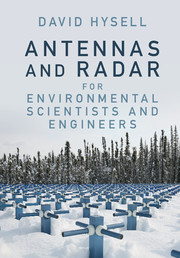Book contents
- Frontmatter
- Contents
- Preface
- 1 Introduction
- 2 Introduction to Antenna Theory
- 3 Antenna Arrays
- 4 Aperture Antennas
- 5 Noise
- 6 Scattering
- 7 Signal Processing
- 8 Pulse Compression
- 9 Propagation
- 10 Overspread Targets
- 11 Weather Radar
- 12 Radar Imaging
- Appendix A Radio Frequency Designations
- Appendix B Review of Electromagnetics
- References
- Index
- References
1 - Introduction
Published online by Cambridge University Press: 09 February 2018
- Frontmatter
- Contents
- Preface
- 1 Introduction
- 2 Introduction to Antenna Theory
- 3 Antenna Arrays
- 4 Aperture Antennas
- 5 Noise
- 6 Scattering
- 7 Signal Processing
- 8 Pulse Compression
- 9 Propagation
- 10 Overspread Targets
- 11 Weather Radar
- 12 Radar Imaging
- Appendix A Radio Frequency Designations
- Appendix B Review of Electromagnetics
- References
- Index
- References
Summary
This text investigates how radars can be used to explore the environment and examine natural and manufactured objects in it remotely. Everyone is familiar with popular portrayals of radar engineers straining to see blips on old-style radar cathode ray tubes. However, the radar art has evolved beyond this cliché. Radars are now used in geology and archaeology, ornithology and entomology, oceanography, meteorology, and studies of the Earth's upper atmosphere, ionosphere, and magnetosphere. Radars are also used routinely to construct fine-grained images of the surface of this planet and others. Astonishingly detailed information, often from otherwise inaccessible places, is being made available to wide audiences for research, exploration, commerce, transportation, security, and commercial purposes. New analysis methods are emerging all the time, and the radar art is enjoying a period of rapidly increasing sophistication.
The invention of radar cannot be attributed to any single individual or event but instead involved scientific and engineering breakthrough occurring across the earth throughout the early part of the twentieth century. By the start of World War II, operational radars could be found in the US, Britain and other Commonwealth countries, France, Germany, Italy, the Soviet Union, Switzerland, The Netherlands, and Japan. Like many technologies, radar was created for niche civilian and scientific applications, developed extensively during wartime, and then exploited for all manner of purposes, from the profound to the mundane. The story of radar is rich and colorful and gives insights into the serendipitous routes by which new technologies emerge.
History
In 1904, German inventor Christian Hülsmeyer obtained patents in multiple countries for an “obstacle detector and ship navigation device” that can be considered a basic kind of radar. The device operated at UHF frequencies and incorporated directional, resonant antennas for transmission and reception along with a rudimentary detection system. The device could detect ships at sea to distances of several km when visibility was poor and give an indication of their distance (indirectly) and bearing. What makes the invention particularly remarkable is that it predated Lee de Forest's vacuum tube radio detector by two years.
Information
- Type
- Chapter
- Information
- Publisher: Cambridge University PressPrint publication year: 2018
